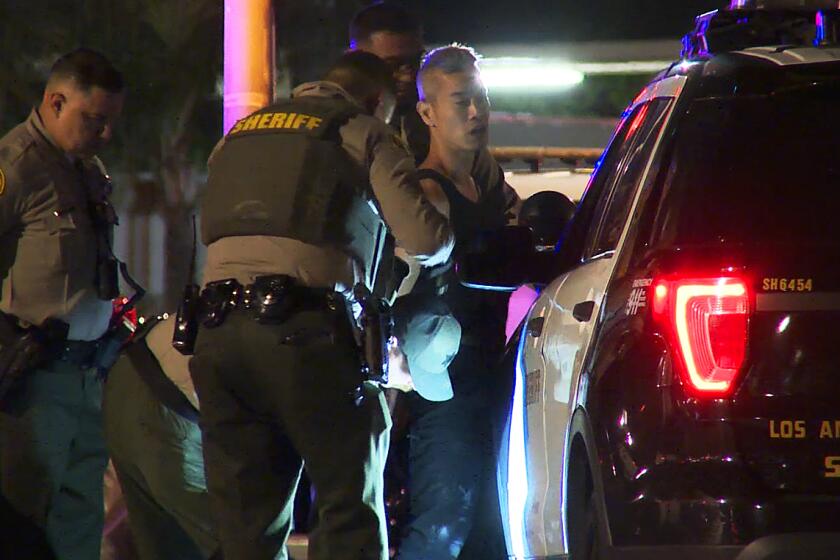Cold comfort on the street
Raymond Byrnes awakens on the cold sidewalk, grips his rosary beads tight and prays for strength -- thankful to have made it through another night on Los Angeles’ skid row.
At 61, he has been homeless for nearly a decade, spending most of his nights at the corner of 5th Street and Gladys Avenue.
At the top of 5th Street, the downtown drug corridor known as “The Nickel,” the crown of the 1,000-foot-tall US Bank Tower glimmers in the black sky. Around the corner on Gladys, a tent city renders both sidewalks impassable. The smell of urine, vomit, feces and garbage hangs in the air.
Each night, Byrnes sleeps in the same spot against a windowless, cinder-block wholesale liquor store -- under a sign that warns “no person shall sit, lie or sleep in or upon any street, sidewalk or other public way.” There’s a homeless shelter two blocks away and others within walking distance, but Byrnes prefers the familiarity of his skid row corner -- no matter how dangerous or difficult it is.
By day, he falls into a routine of military precision that would have made his Army colonel/ police chief/prison warden Irish American father proud.
Today, like most of Byrnes’ days, starts at 5 a.m. Over the next 24 hours he can count on one meal, two church services and a dozen cups of coffee -- all the sustenance he’ll need to survive.
“My philosophy is you find what you need,” he says.
Byrnes rolls up his handmade sleeping bag and packs his lone knapsack with a tattered cardigan sweater, a stocking cap embroidered with “L.A.” and a patched jacket. Everything has a place and everything is in its place.
In an outside pocket, he stuffs his own personal concoction of spicy lemonade: a blend of lemon, lime, grapefruit and jalapeno in an old soda bottle. The juice doubles as a drink and holy water.
In another pocket, he stores seven rosaries -- one for each day of the week. Blue for Monday, red for Tuesday, yellow for Wednesday. He swaps out yesterday’s rosary for today’s and begins the Apostles’ Creed.
Finally, he folds up a blue plastic tarp that serves as his mattress, revealing a faintly smudged cross on the sidewalk: an X marking his spot.
His ragamuffin wardrobe rarely changes: scavenged Rockport sandals, threadbare socks, high-water khaki pants and an oversized Lakers T-shirt. He pulls his thinning hair into a short ponytail. His defining characteristic: an unruly gray Santa Claus beard that stretches to the top of his round belly.
Careful to avoid the drug dealers and drug-addled of skid row, Byrnes walks with a slight waddle across downtown to Olvera Street. Always following the same route, he passes the cold storage warehouses along Central Avenue and slips through relatively tame and tidy Little Tokyo.
By 6 a.m., he’s in his pew -- row 10, left side, against the adobe wall -- at La Placita Church, a Catholic chapel adjacent to the city’s historic center. He bows his head toward the impressive gold leaf altar and prays until the Mass begins.
Up to a quarter of the 50 or so regular attendees are homeless. From memory, he sings along and recites the prayers -- all in Spanish. It’s a language he studied in high school and college but mastered only in church. The holy Eucharist is his first food of the day.
As soon as the Mass ends, the homeless and near-homeless quickly file out to form a line for free coffee and sweets -- a big draw for the predawn service. Byrnes takes two of each.
After church (and a refill of coffee), Byrnes walks the few blocks to Philippe’s, a Los Angeles institution known equally for its French dip sandwiches and 9-cent cups of coffee. The waitress recognizes him and pours his usual: two cups of coffee for 18 cents.
It’s his first and often only expense of the day. Sometimes he visits Grand Central Market to stock up on spicy lemonade supplies or a fabric store for needle and thread. But not today.
A handful of the homeless gather in a side room of Philippe’s to kibitz about the past night and the day ahead. Byrnes knows them all but keeps to himself. He has work to do.
He spreads out his project at his favorite table next to a window overlooking Alameda Street. Fifty pages, hand-bound with needle and thread, of pencil sketches and schematic drawings. He’s been toiling at the task -- what he calls his personal obsession -- for seven years now. He says he’s half-finished.
The intricate and meticulous diagrams detail the inner workings of the boiler controls for a ship’s steam turbine. It’s the same project he was working on when he lost his job in 1975. His great hope is to pitch the proposal to an energy company.
“This is just an extension of the work I was doing 30 years ago,” Byrnes says.
*
The oldest of three Army brats, Raymond Joseph Byrnes spent his childhood hopping from base to base in Japan, Germany and elsewhere around the globe before returning to California during his high school years.
In 1968, he graduated with a bachelor’s degree in marine engineering from the U.S. Merchant Marine Academy at Kings Point, N.Y. To fulfill his collegiate obligations, he joined the merchant marine and went to sea as a sailor during the Vietnam War.
After the service, he married a woman he met in a New York discotheque and landed a job on Madison Avenue planning projects for a large heating and cooling company. The pair settled down, bought a house and had a son.
“It was the perfect life,” he says. “I couldn’t believe it. I had reached the pinnacle.”
Then, in 1975, everything went wrong. He lost his job, the house and his wife. He spent several months in a psychiatric clinic. Recalling the details makes the normally mild-mannered and well-spoken Byrnes confused and flustered.
“All I could think was, ‘How could this happen?’ ” he says.
He’s been in a downward spiral ever since. He moved from city to city and job to job until he finally bottomed out on the streets of Los Angeles. Desperate, he contemplated suicide. He was robbed and beaten. He struggled, adapted and survived.
He spent the next five years in various homeless shelters, moving on when the rules grew too restrictive. He has lived at 5th and Gladys for the last five years.
Byrnes’ son, Terence, reached by a Times reporter at his home in North Carolina, said he had not talked to his father in 10 years. He said he didn’t want to talk about his family but confirmed the broad strokes of his father’s life before he started living on the streets.
*
After a second round of coffee, Byrnes packs up his project -- careful not to spoil his privileges at Philippe’s.
“I usually try to leave by 9 a.m. when the tourists and the money crowd comes in,” he says.
He heads across downtown to visit an old friend from church, Tony Spinetti. The 80-year-old former cab driver and mentor to Byrnes lives in a rent-controlled, federal Housing and Urban Development apartment complex on 7th Street.
For the last few months, ever since Spinetti had a stroke, Byrnes has been caring for his friend -- sorting his medication, setting out his clothes, cleaning his room. The chores fit Byrnes’ pro-organization, anti-sloppiness personality. For his efforts, Spinetti pays Byrnes a dollar a day. It’s all the money he needs.
Spinetti’s place is nothing fancy, but compared to the streets it’s the lap of luxury: toilet, shower, laundry, wall-to-wall carpeting, even air-conditioning. Statues and portraits of religious icons decorate the spartan apartment.
Byrnes searches the fridge and finds a half-eaten bundt cake, a few day-old rolls, a couple of candy bars and some bottled water. The cupboards are nearly as bare. Byrnes makes lunch every day, often ramen, spaghetti or rice. And, of course, a pot of coffee. It’s often his only meal of the day. Before they eat, Byrnes says grace.
In the afternoon, they listen to talk radio and discuss the day’s events: politics, hot-button issues and the latest scandals. Spinetti is frank and free with his opinions. Debate makes Byrnes’ intense blue eyes sparkle.
About 3 p.m., Byrnes says so long to Spinetti. The management prohibits overnight guests. Byrnes hopes Spinetti will bend the rules when winter rains come.
A year from now, when he’s 62 and his Social Security checks start flowing, Byrnes could apply for a room in the HUD building -- but he doesn’t want to. He hopes to move into the King Edward, a run-down skid row hotel on 5th Street with fewer rules.
Back across downtown at La Placita Church, Byrnes is in his pew again for the evening service. The ushers pass the collection basket, and Byrnes folds his hands and bows his head. The priest delivers the Gospel message: All will be with Jesus in the final forever.
After church, Byrnes retraces his steps to 5th and Gladys. Nighttime on skid row is far scarier than dawn.
A strung-out woman sings in the middle of the street, screams at passing traffic, smashes a bottle on the pavement and openly smokes crack cocaine on the corner. Byrnes ignores the commotion.
“Being homeless, you gain a lot of strength,” he says. “You have to act strong. You just let your fears go.”
He also has to contend with occasional police sweeps. In 2005, Byrnes was arrested for obstructing the sidewalk.
He refused to go to a homeless shelter as ordered by officers and instead spent a week in jail. When he got out, all his possessions were gone.
Uncapping his lemonade, he pours the juice on the sidewalk in the sign of a cross to mark his spot.
He makes his bed and cracks open his Spanish-language Gideon’s Bible to review tomorrow’s Gospel readings.
Tucking himself in, he tugs his stocking cap over his eyes to blot out the streetlight directly overhead. Only his beard peeks out of the sleeping bag.
As he falls asleep, Byrnes grips a rosary tight in his hand with the cross poking out between his fingers. It’s part religious talisman and part defensive weapon.
*
More to Read
Start your day right
Sign up for Essential California for news, features and recommendations from the L.A. Times and beyond in your inbox six days a week.
You may occasionally receive promotional content from the Los Angeles Times.







